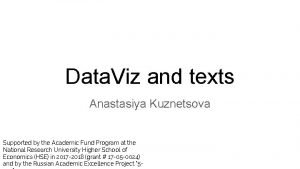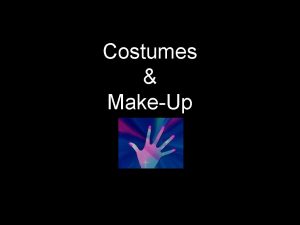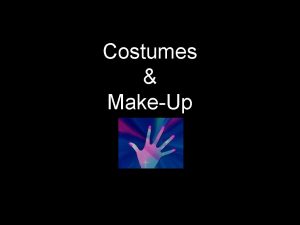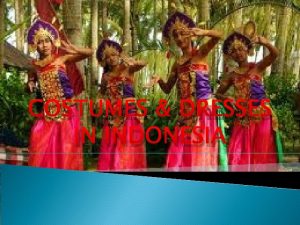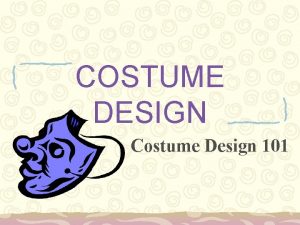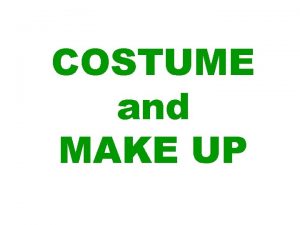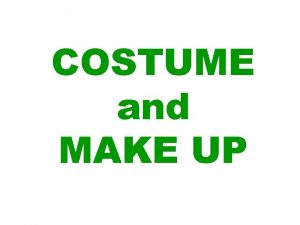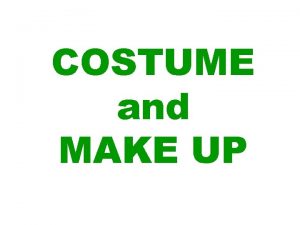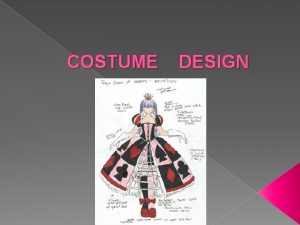COSTUMES MASKS Anastasiya Kochergina Evidence for Comic Costume










- Slides: 10

COSTUMES & MASKS Anastasiya Kochergina

Evidence for Comic Costume ■ Archaeological – Terra cotta figures of comic actors – Vase paintings of comic scenes ■ ■ Issue of color Issue of space ■ Textual – The plays themselves ■ ■ Anomalous costumes v. normal comic costume Verbal references to costume ■ Aristotle’s Poetics


Costumes ■ Costume – Padded rump & stomach – Male characters also wore a large phallus ■ Masks – Distortion of the face

Costume Manipulation (Part 1) ■ Voluntary stripping – Removal of costume by members of chorus – Removal of clothing by characters in Lysistrata – Removal of clothing as a sign of defeat ““ἡττήμεθ᾽: ὦ κινούμενοι / πρὸς τῶν θεῶν δέξασθέ μου / θοἰμάτιον, ὡς / ἐξαυτομολῶ πρὸς ὑμᾶς. ” (Ar. Clouds 1101 -4) (We are defeated: o [you] fuckers, by the gods, receive my cloak, for I desert to you)

Costume Manipulation (Part. 2) ■ Involuntary Stripping – Show of force; this normally occurs to unlikeable characters – Peisetaeus orders a servant to take off his clothes in Birds (933 -4, 947 -8) – Euripides orders the flute girl in Women at the Thesmophoria to take off some of her clothes (1181 -3) Δικαιόπολις: οὐκ οἶδά πω: / ὑπὸ τοῦ δέους γὰρ τῶν ὅπλων εἰλιγγιῶ. / ἀλλ᾽ ἀντιβολῶ σ᾽ ἀπένεγκέ μου τὴν μορμόνα. / Λάμαχος: ἰδού. / Δικαιόπολις: παράθες νυν ὑπτίαν αὐτὴν ἐμοί. / Λάμαχος: κεῖται. (Ach. 581 -6) Dikaeopolis: I don’t know at all. / For I might faint under the fear of your weapons. / But, I entreat you, take that horrible she-monster from me. / Lamachus: there. / Dikaeopolis: Now give your feather to me. / Lamachus: it is laid out.

Costume Manipulation (Part. 3) ■ Addition of Clothing or Accessories – A character is shown for the first time in their full costume – Some objects can be added to their costume as an ‘overlaying’ of identity ■ Acharnians: the snouts and hooves worn by the Megarian’s daughters ■ Lysistrata: the veil and weaving equipment worn by the Proboulos

Costume Changes & Exchanges (Part 4) ■ The costume itself is the vehicle for an exploration of status. ■ Change in costume can be used to signify a change in status ■ Exchanges – Characters trade costumes in scenes that focus on dichotomized social roles – Characters trying to create their changes in status themselves by way of costume (e. g. Dionysus in Frogs)

Bibliography ■ Beare, W. and T. B. L. Webster. 1957. "Aristophanic Costume Again. " Classical Quarterly 7: 184 -5. ■ Beare, W. 1959. "Aristophanic Costume: A Last Word. " Classical Quarterly 9: 126 -7. ■ Compton-Engle, G. 2003. "Control of Costume in Three Plays of Aristophanes. " American Journal of Philology 124: 507 -35. ■ Compton-Engle, G. 2015. Costume in the Comedies of Aristophanes. Cambridge: Cambridge University Press. ■ English, M. C. 2007. "Reconstructing Aristophanic Performance: Stage Properties in "Acharnians". " Classical World 100: 199 -227. ■ Stone, L. M. 1984. Costume in Aristophanic Comedy. Salem, MA: Ayer. ■ Wiles, D. 2008. “The Poetics of the Mask in Old Comedy”, in M. Revermann and P. Wilson (eds. ), Performance, Iconography, Reception: Studies in Honour of Oliver Taplin (Oxford): 374– 92.

FINIS
